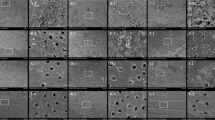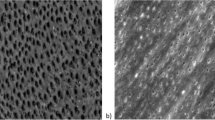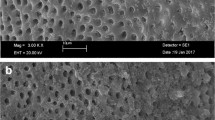Abstract
The purpose of this study was to evaluate the effect of diode laser irradiation on Enterococcus faecalis (E. faecalis) and its lipoteichoic acid (LTA). Ninety-six freshly extracted single-rooted teeth were divided into six groups, n = 8 per group. Groups 1, 2, 3, and 4 as laser group (810 nm PILOT™ Diode Laser, 400 μm fiber diameter, continuous mode, 30 s time) with powers at 1.0 W, 1.5 W, 2.0 W, and 2.5 W respectively. Group 5 or positive control group (3 ml of 1% sodium hypochlorite (NaOCl) irrigation) and group 6 or negative control group (3 ml of normal saline (0.9% NaCl) irrigation). Root canal samples were collected before and after receiving laser irradiation and irrigation solution. Cultivable bacteria were determined by counting the colony (CFU/ml). Evaluation of temperature on the external root surface of teeth was done with K type thermocouple using laser at different powers. Enzyme-linked immunosorbant assay (ELISA) was performed to measure the LTA levels and the correlations between E. faecalis count, LTA levels, and rise in temperature were observed using Pearson’s correlation test. E. faecalis LTA was subjected to laser irradiation and its structural damage was examined by thin layer chromatography (TLC). Compared with the control groups, all laser groups showed a decreased colony counts and decreased LTA levels with statistically significant difference (p ˂ 0.05). The bactericidal effect and LTA reduction of laser was better at 2.5 W power. Laser at 2.5 W power had temperature rise of more than 7 °C which is beyond the safe thermal threshold level. No statistically significant correlation was found between E. faecalis count, levels of LTA, and rise in external root surface temperature (p ˃ 0.05). TLC results showed a structural damage in the glycolipid moiety of E. faecalis LTA. Diode laser can effectively reduce the E. faecalis count and its LTA levels.




Similar content being viewed by others
References
Barbosa-Ribeiro M, De-Jesus-Soares A, Zaia AA, Ferraz CCR, Almeida JFA, Gomes BPFA (2016) Antimicrobial susceptibility and characterization of virulence genes of Enterococcus faecalis isolates from teeth with failure of the endodontic treatment. J Endod 42(7):1022–1028. https://doi.org/10.1016/j.joen.2016.03.015
Kasić S et al (2017) Efficacy of three different lasers on eradication of Enterococcus faecalis and Candida albicans biofilms in root canal system. Photomed Laser Surg 35(7):372–377
Alghamdi F, Shakir M (2020) The influence of enterococcus faecalis as a dental root canal pathogen on endodontic treatment: a systematic review. Cureus. 12(3):e7257. https://doi.org/10.7759/cureus.7257
Kayaoglu G, Ørstavik D (2004) Virulence factors of enterococcus faecalis: relationship to endodontic disease. Crit Rev Oral Biol Med 15(5):308–320
Strateva T, Atanasova D, Savov E, Petrova G, Mitov I (2016) Incidence of virulence determinants in clinical Enterococcus faecalis and Enterococcus faecium isolates collected in Bulgaria. Braz J Infect Dis 20(2):127–133
Kiku Y, Nagasawa Y, Tanabe F, Sugawara K, Watanabe A, Hata E, Ozawa T, Nakajima K, Arai T, Hayashi T (2016) The cell wall component lipoteichoic acid of Staphylococcus aureus induces chemokine gene expression in bovine mammary epithelial cells. J Vet Med Sci 78(9):1505–1510
Ahn JE, Kim H, Chung DK (2019) Lipoteichoic acid isolated from Lactobacillus plantarum maintains inflammatory homeostasis through regulation of Th1- and Th2Induced cytokines. J Microbiol Biotechnol 29(1):151–159
Bhakdi S, Klonisch T, Nuber P, Fischer W (1991) Stimulation of monokine production by lipoteichoic acids. Infect Immun 59:4614–4620
Yoo Y-J, Perinpanayagam H, Soram O, Kim A-R, Han S-H, Kum K-Y (2019) Endodontic biofilms: contemporary and future treatment options. Restor Dent Endod 44(1):e7
Jhajharia K, Parolia A, Shetty KV, Mehta LK (2015) Biofilm in endodontics: a review. J Int Soc Prev Community Dent 5(1):1–12
Hong SW, Baik JE, Kang SS, Kum KY, Yun CH, Han SH (2016) Sodium hypochlorite inactivates lipoteichoic acid of Enterococcus faecalis by deacylation. J Endod 42(10):1503–1508
Lee JK, Baik JE, Yun CH, Lee K et al (2009) Chlorhexidine gluconate attenuates the ability of lipoteichoic acid from Enterococcus faecalis to stimulate toll-like receptor 2. J Endod 35(2):212–215
Baik JE, Kum KY, Yun CH et al (2008) Calcium hydroxide inactivates lipoteichoic acid from Enterococcus faecalis. J Endod 34(11):1355–1359
Subramani SM, Anjana G et al (2019) Evaluation of antimicrobial efficacy and penetration depth of various irrigants into the dentinal tubules with and without lasers: a stereomicroscopic study. Int J Clin Pediatr Dent 12(4):273–279
Gutknecht N, Van Gogswaardt DI et al (2000) Diode laser radiation and its bactericidal effect in root canal wall dentin. J Clin Laser Med Surg 18(2):57–60
Vatkar NA, Hegde V, Sathe S (2017) Vitality of Enterococcus faecalis inside dentinal tubules after five root canal disinfection methods. J Conserv Dent 19(5):445–449
Rahimi S, Janani M, Lotfi M et al (2014) A review of antibacterial agents in endodontic treatment. Iran Endod J 9(3):161–168
Rabello DGD et al (2017) Does supplemental photodynamic therapy optimize the disinfection of bacteria and endotoxins in one-visit and two-visit root canal therapy? A randomized clinical trial. Photodiagnosis Photodyn Ther 19:205–211
Pearson GJ, Schuekert KH (2003) The role of lasers in dentistry: present and future. Dent Update 30(2):70–74
Gutknecht N et al (2016) The bactericidal effect of 2780 and 940 nm laser irradiation on Enterococcus faecalis in bovine root dentin slices of different thicknesses. Photomed Laser Surg 34(1):11–16
Beer F, Buchmair A, Wernisch J, Georgopoulos A, Moritz A (2012) Comparison of two diode lasers on bactericidity in root canals-an in vitro study. Lasers Med Sci 27(2):361–364
Gutknecht N, Franzen R, Meister J, Vanweersch L, Mir M (2005) Temperature evolution on human teeth root surface after diode laser assisted endodontic treatment. Lasers Med Sci 20(2):99–103
Seraj B, Moosavi Garmaroodi Z, Chiniforush N, Ghadimi S (2018) Thermal changes in root surface of primary teeth during root canal treatment with diode lasers: an in vitro study. J Lasers Med Sci 9(4):237–242
de Almeida Gomes BPF, Herrera DR (2018) Etiologic role of root canal infection in apical periodontitis and its relationship with clinical symptomatology. Braz Oral Res 32(Supp.1):e69. https://doi.org/10.1590/1807-3107bor-2018.vol32.0069
Hara et al (2018) The NLRP6 inflammasome recognises lipoteichoic acid and regulates gram positive pathogen infection. Cell. 175(6):1651–1664
Sarda RA, Shetty RM, Tamrakar A, Shetty SY (2019) Antimicrobial efficacy of photodynamic therapy, diode laser and sodium hypochlorite and their combinations on endodontic pathogens. Photodiagnosis Photodyn Ther 28:265–272. https://doi.org/10.1016/j.pdpdt.2019.09.009
Virdee SS et al (2018) Efficacy of irrigant activation techniques in removing intracanal smear layer and debris from mature permanent teeth: a systematic review and meta-analysis. Int Endod J 51(6):605–621
Saydjari Y, Kuypers T, Gutknecht N (2016) Laser application in dentistry: irradiation effects of Nd:YAG 1064 nm and diode 810 nm and 980 nm in infected root canals—a literature overview:8421656. https://doi.org/10.1155/2016/8421656
Acknowledgments
This study was supported by grants from the National Natural Science Funds of China (No. 11601502/XK0127).
Author information
Authors and Affiliations
Corresponding author
Ethics declarations
Conflict of interest
There authors declare that there are no conflicts of interest.
Ethical considerations
The ethical committee of Tianjin Medical University, Stomatology Hospital, Tianjin approved this study (TMUhMEC2019035).
Additional information
Publisher’s note
Springer Nature remains neutral with regard to jurisdictional claims in published maps and institutional affiliations.
Zhaohui Zou and Junu Bhandari are co-first authors.
Rights and permissions
About this article
Cite this article
Zou, Z., Bhandari, J., Xiao, B. et al. Effect of using diode laser on Enterococcus faecalis and its lipoteichoic acid (LTA) in chronic apical periodontitis. Lasers Med Sci 36, 1059–1066 (2021). https://doi.org/10.1007/s10103-020-03146-4
Received:
Accepted:
Published:
Issue Date:
DOI: https://doi.org/10.1007/s10103-020-03146-4




